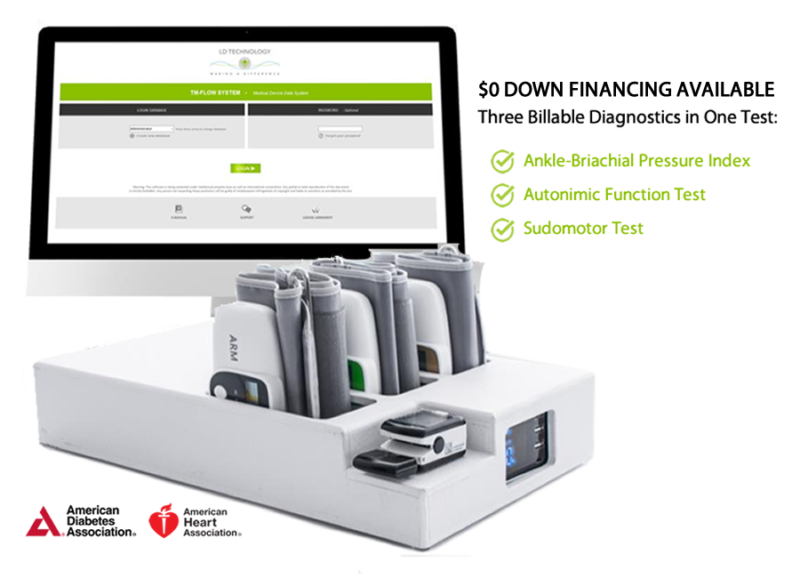Frequently Asked Questions
The TM Flow device offers numerous benefits for medical practices, including non-invasive and accurate testing, early detection of autonomic and arterial dysfunctions, and comprehensive diagnostics that reduce the overall cost of patient care. Additionally, the device’s tests are easy to bill with multi-code diagnostics, making it a valuable investment for enhancing patient care and optimizing practice efficiency. It also supports compliance with standards of care recommended by leading health organizations.
Yes, the TM Flow device is covered by Medicare and most private pay carriers. Specific CPT codes, such as 95921 for cardiovagal innervation and 93923 for ankle-brachial pressure index, ensure that the diagnostics are easy to bill. Coverage and reimbursements may vary depending on the Medicare locality, but the comprehensive diagnostics offered by the TM Flow device are widely recognized and supported by insurance providers.
Autonomic nervous system testing is crucial for diabetes and cardiovascular patients because it helps in the early detection of autonomic neuropathy, which is a common complication in these conditions. Early detection through ANS testing allows for timely intervention and management, reducing the risk of further complications. The American Diabetes Association recommends ANS testing as a standard of care for patients with Type 1 and Type 2 diabetes, highlighting its importance in effective diabetes management.
The TM Flow device is an advanced, non-invasive diagnostic tool designed to perform a series of tests that aid in the identification and early detection of autonomic nervous system (ANS) and arterial dysfunctions. It provides quantitative assessments of the ANS, helping to distinguish between early and late stages of autonomic neuropathy. The TM Flow device is particularly valuable for cardiovascular and diabetic autonomic neuropathy (DAN) testing, making it an essential tool in diabetes management and cardiovascular assessments.
During an ANS evaluation, the CAN assessment comprises of the heart rate variability analysis and the cardiac autonomic reflexes tests or Ewing Tests. These test the function of the sympathetic and parasympathetic systems to identify cardiac autonomic neuropathy. There are a series of tests including the Valsalva ratio, deep breathing test, a change in posture and the difference in systolic pressure from sitting to standing position.
Heart rate variability is a variation in time interval between heartbeats. It is measured by the variation in the beat-to-beat intervals. The Autonomic nervous system plays a central role in heart rate variability. Depressed or reduced heart rate variability primarily means a lower ability of the ANS regulatory function to keep homeostasis, cope with internal and external stressors and resist disease and/or recover in proper time
The Valsalva maneuver involves holding the breath, bearing down and then blowing into a manometer without releasing air from the nose or mouth. Its purpose is to evaluate the parasympathetic system heart rate response and sympathetic system blood pressure response.
The deep breathing test involves deep breathing for a total of 60 seconds; five second intervals of inspiration and expiration. Its purpose is to evaluate the parasympathetic system heart rate response.
The postural change test involves a change in posture from lying down or sitting to standing. The purpose of the test is to evaluate the sympathetic system blood pressure response to standing and the parasympathetic evaluation of heart rate response.
The RR intervals and blood pressure analysis combine to give a diagnosis of cardiac autonomic neuropathy using a scoring system. Heart rate variability analysis at rest includes self-body regulation assessment related to the level of fitness in early stages of cardiac autonomic neuropathy. Cardiac autonomic reflex tests include heart rate variability and blood pressure analysis during Valsalva maneuver deep breathing and change of posture.
RSS FEED
- The TM Flow is a highly reimbursable diagnostic in Portland, OR
- Pain Clinics in Albuquerque, NM Adopt the TM Flow as Gold Standard
- Neuropathy in Philadelphia, PA can be detected with the TM Flow device
- Pain Management Clinics in Dallas, TX are Using the TM Flow to Diagnose Symptoms
- Unlocking the Potential of ANS Testing: Insights for Healthcare Providers
- Neuropathy clinics in Savanah, GA use the TM Flow
- Come to Charleston, WV to Get a TM Flow
- How the TM Flow will maximize your physician practice in Boise Idaho
- Doctors in Pittsburg, PA are using the TM Flow for the treatment of neuropathy
- Which Patients Require ANS Testing?
